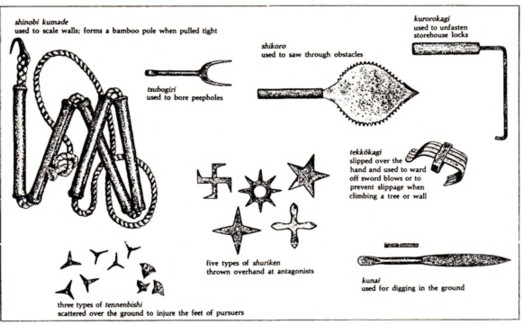NINJA
(Investigator 25, 1992 July)
(Investigator 25, 1992 July)
You've probably seen the "ninja" on TV. There are all sorts of them — American ninja, one-armed ninja, good ninja, evil ninja, women ninja, phantom ninja, mutant ninja turtles, etc.
They wear what looks like pyjamas, hide their faces with scarf or veil, can jump ten metres into the air, somersault over speeding trucks, practice martial arts and spectacular swordplay, create instant smokescreens with gunpowder charges, are expert at kicking enemies in the groin, can climb up trees like monkeys, and can scamper up walls on ropes with attached hooks.
In many films the good ninja is an American who faces the champion of the evil ninja in a climactic swordfight and kicking contest during the final ten minutes. The obvious exception to this is Shintaro.
Remember Shintaro?
He was one of the few Japanese to become a hero among Australians! The TV series The Samurai was filmed in 1962-1964 and first appeared on Australian television in 1963. The show was famous for its action scenes and its atrocious dubbing. At times the ninjas spoke whole paragraphs without moving their lips. On other occasions they screamed "Shintaro, you die!" and were still talking after Shintaro killed them!
The actor who played Shintaro, Koichi Ose, is now 54. He appeared in twenty films after the TV series and retired from acting in 1969. Thereafter he became a businessman and property developer and is still alive and well.
Genuine ninja also exist.
Australasian Post (1989 July 8) had an article titled: "Deadly ninja gangs crush Perth Racists". In part it said: "One of the world's three living ninja grandmasters has vowed to protect the ethnic community against racist threats. John Ang, president of the World Ninja Society, has launched a dial-a-ninja service, offering his highly-trained ninja warriors to help anyone threatened with racial violence."
Apparently the ninja are not as athletic or acrobatic as portrayed in the movies. None, for example, are known to have become Olympic gold medalists!
Ninjutsu is: "The ancient art of subterfuge; a supposedly magical art for making oneself invisible by artifice or stratagem in order to evade detection." Practitioners of ninjutsu were a kind of spy known as ninja (secret agents).
Ninjutsu flourished in 15th and 16th century Japan when rival warlords hired ninja to spy on enemies.
The two items below were received "With the Compliments of the Embassy Japan, Canberra".
An additional handwritten note said: "We were not able to find information on Olympic gold medalists among practitioners of ninjutsu."

Implements
used by Ninja
| SAMURAI'S
TRAINING "Samurai", is as a rule, a soldier. The Boys' Festival of May 5 reminds the people of "samurai" or fighting men, whose deeds of bravery, courage and loyalty are told brilliantly in history and tradition. For many centuries "samurai" ruled the country, and as fighting was their principal duty, they were required to be skilful in the art of war. Swords were the principal weapon then, and they even worshipped swords as the emblem of their duty and spirit. But to gain the masterly skill in using swords for attack and defence, they had to go through most strenuous training. The physical handling of swords alone did not make a master swordsman. Not only in battles which were the man-to-man affair, but even in their daily life, "samurai" needed to be constantly prepared for a hostile attack. Thus they had to develop their five senses, and learn to concentrate their mind. To this end, many "samurai" studied the Zen doctrine of Buddhism, because Zen meditation gave them calmness and composure of mind, and increased their power of vision. MASTERS OF INVISIBILITY As rivalry and suspicion among military leaders became intense in the feudal days, the art of spying suddenly developed. Spies were sent to the territories of neighboring or hostile lords to obtain information as to their plans and intentions. These expert spies finally succeeded in attaining "ninjutsu" or the art of invisibility. Legends and popular tales describing the campaigns of military lords usually exaggerated the art of invisibility, and made these experts almost superhuman magicians able to become invisible at their wish. All this is, however, mere fiction. Nevertheless "ninjutsu" experts did really exist. They attained their art only after several years of hard and difficult training. First they learned to walk and run faster than ordinary persons, and trained themselves to go without eating and sleeping for several days. This ability of quick physical movement and endurance was the first step. Then, as the second step, they learned to walk softly end noiselessly anywhere, to climb up perpendicular walls, jump over high fences, open and shut doors, without making any noise, see things in semi darkness and to have a specially keen sense of hearing. A "ninjutsu" expert dressed himself in a tight black costume, covering his entire head end face except for openings for the eyes. He selected a moonless night, and scaled the outer wall or fence of the place he intended to enter. Opening a convenient door noiselessly he entered the house. If he met anyone in the corridor, he flattened himself against the side wall or jumped up and held his body in mid-air above the person, by grabbing the side posts. He went where ever he pleased and listened to the talks of the members of the household, or carried away anything that would be valuable in knowing the affairs of the family. |